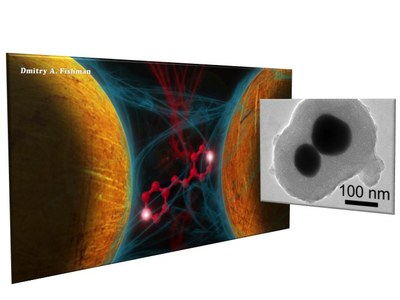Aug 19, 2014
For the first time, chemists have succeeded in measuring vibrational motion of a single molecule with a femtosecond time resolution. The study reveals how vibration of a single molecule differs from the behaviour of larger molecular groups. In conjunction with the study, the scientists developed a new method for identifying single molecules by optical means.
The study was performed at the University of California, Irvine, where post-doctoral researcher Eero Hulkko from the University of Jyväskylä works as a visiting fellow under professor Vartkess A. Apkarian, whose team participated in the study. The second team was lead by Professor Eric O. Potma. The results of the study made the cover of the August issue of the prestigious Nature Photonics magazine.
The scientists employed ultra-short femtosecond (10-15 s) laser pulses in the visible light spectrum to measure the motion of individual molecules.
Seeing a single organic bipyridylethylene (BPE) molecule vibrate as a function of time was possible through the scattering of the light pulses. The method is known as time-resolved coherent anti-Stokes Raman scattering (tr-CARS).
Aided by gold nanoantennas
The observations of single BPE molecule vibrations was possible using so called “plasmonic nanoantennas”, which consist of two gold nanoparticles of approximately 90 nanometres. A nanometre is one billionth of a meter. The nanoantennas amplify the radiation from a single molecule to a detectable level.
“Detecting one molecule through scattering of light is extremely difficult”, says Doctor Hulkko, who participated in the study, “which is why we needed to amplify the signal”.
Nanoparticle amplification of molecular signals is employed in various spectroscopic techniques, such as surface-enhanced Raman scattering (SERS), which is used for routine detection of single molecules.
Vibrations in a single molecule are strictly governed by quantum mechanics.. In order to be detectable with the method, a molecule has to be in two (or more) quantum states at once. In quantum mechanics, this is known as coherent superposition of vibrational states – a wave packet. In molecular groups, the states within the wave packet usually lose their phase correlation within a short period of time. This is called dephasing.
Lack of dephasing observed for the first time
With the aid of laser pulses, the scientists were able to create a wave packet of the single molecule vibrations and monitor it during 10 picoseconds (1 picosecond = 10 to the power of -12 seconds). The time dependent motion of the wave packet corresponds to the actual vibrations of the molecule, i.e. its molecular “breathing”.
The tests proved that the vibrations of a single molecule did not lose their phase correlation. Using simulations, the scientists were able to explain the observations and show that pure dephasing is a characteristic of molecular groups. The lack of dephasing in single molecules is a fundamental and hitherto unknown finding.
“Observing the breathing of a single molecule takes us one step closer to seeing real chemistry at work at the level of a single molecule”, Professor Apkarian predicts.
Demonstrating coherent ultrafast spectroscopy at the single-molecule level – in other words, being able to generate, manipulate and measure the quantum states of a single molecule – opens up new possibilities for quantum computing using molecules and quantum information transfer.
In practice, single molecules means that we are observing individual photons. Consequently, the results open new research avenues and applications within single-molecule photonics, such as generating single photons in a desired state.
Source:
https://www.jyu.fi/en/news/archive/2014/08/tiedote-2014-08-19-13-31-10-735823















